![]()
Call me a culinary thief, but I love cooking passed-down family recipes from other peoples’ families. I say that with a bit of mischievousness because usually, the recipe-writer—the nonna, auntie, etc.—had shared their recipe with someone whom they love, but they probably never imagined that it would one day be used by a total stranger, me. It’s kind of thrilling.
Furthermore, we tend to think of family recipes as something sacred, something not to mess with so as to fully respect and cherish the recipe-writer. But when that person has almost no connection to us, it’s easier to deviate from their words. And to make that recipe suit our purposes, make it a little easier on us. That’s what I did with this recipe for “sauce,” which comes to me from a splattered old letter that was given to my aunt Ellen by her high school boyfriend’s mother, Mrs. Muce. My aunt has been cooking Mrs. Muce’s sauce occasionally her whole adult life; the first time I tried it was as a child, when she visited my family. Ellen loves this recipe so much—it’s the kind of thing that she makes for guests, because it takes quite a while to cook, and Ellen isn’t terribly into cooking. I remember how her eyes lit up like a child’s on Christmas morning as she stirred and tasted the sauce from a wooden spoon at our house. It was ready, she declared.
Gathering source material from all types of regular home cooks like other peoples’ moms is actually the province of a good cookbook writer. I had just chatted with one, Alana Kysar, author of Aloha Kitchen, on Heritage Radio Network last weekend, and in her book, she shares a couple family recipes from her boyfriend’s Hawai’ian mom, who had never written any of them down before. It’s great to cook on and on from one’s own trove of family recipes. But then you realize that everyone’s family has great kitchen secrets, and we have a lot to learn from them.
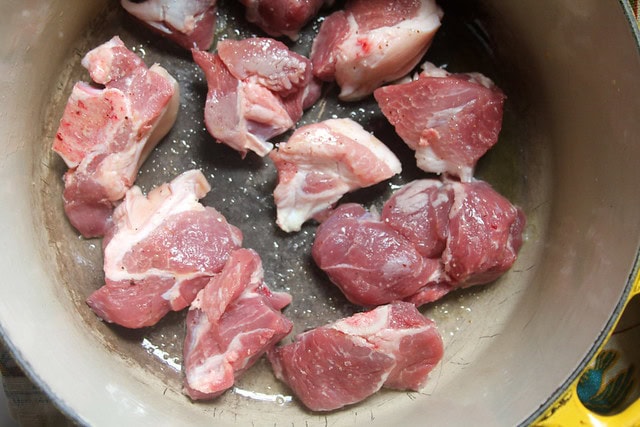
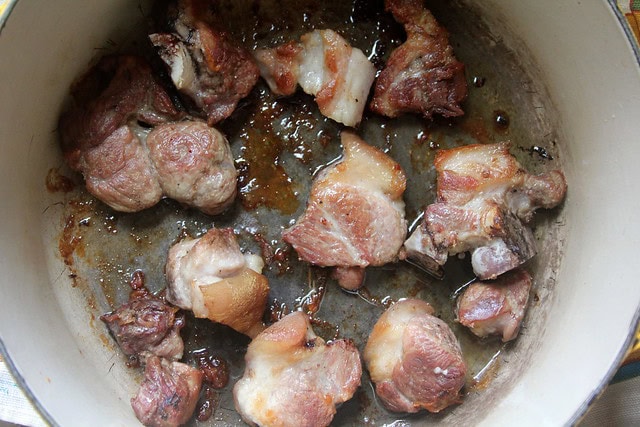
Mrs. Muce’s letter-with-a-recipe was written with a typewriter that had the kind of faux script font you’d see often in the 1960s. She had clearly been goaded into sharing some kitchen wisdom, because after a couple paragraphs sharing notes on her home life and asking about Ellen’s, she writes, “Ellen, how do I start on soup and sauce. You know it’s a little bit of this and that, but I will give it a try.” Then proceeds loose recipes-with-jokes-and-asides for chicken soup, for meatballs, and for “sauce.” The sauce recipe has a variation with Italian pork sausage and pork, where she encourages my aunt to at least use a couple of pork chops for flavor if not sausage, something that she knew her recipient did not like.
I took the route of no Italian sausages following that suggestion not intended for me. I used chunks of bone-in pork shoulder instead of chops, which I thought might cook in due time while providing some treats for my dog to nibble on afterward. Mrs. Muce simply writes that the chops should be roasted for an hour at 350 degrees before adding to the tomato sauce, then cooked another 2-3 hours with it. You have to imagine that the meat simply gets tender enough to fall apart on its own in the tomatoes, but I didn’t have to imagine it, because that’s what the end product was like when Ellen made this sauce long ago for me—shreds of pork veined throughout like a stew. I had never had a pasta sauce like it before at the time.
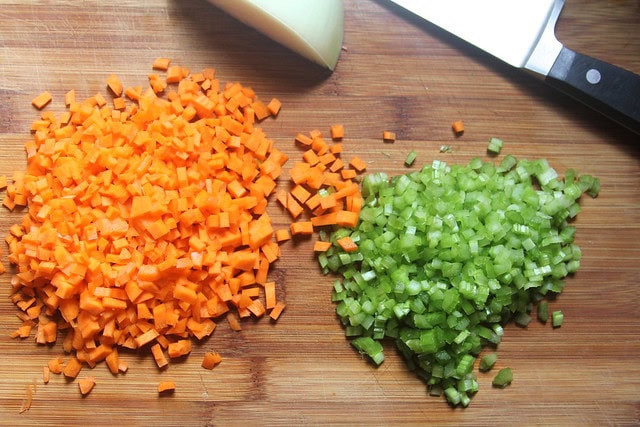
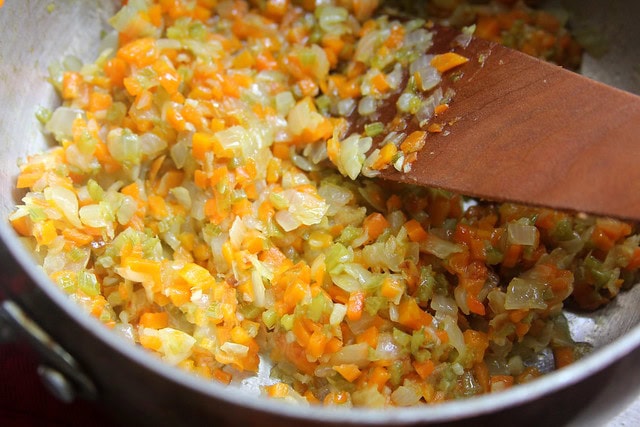
I went and added some finely chopped vegetables to the sauce, cooked down to a gooey sludge, like I’d seen in other recipes for long-simmered meaty ragus (following the edict of “a little this and that,” while straying from what was written on the paper). This is the kind of soothing, hearty stew that you could probably sneak random vegetables into and not notice much difference in the end. The sauce doesn’t even have to be that rich—I did good wiping away much of the rendered fat with a paper towel, saving the skin and clumps of fat for my dog or for other uses, but leaving the crusty, browned goodness on the bottom of the Dutch oven that the pork roasted in to soak into the sauce. That’s where the flavor is really concentrated.

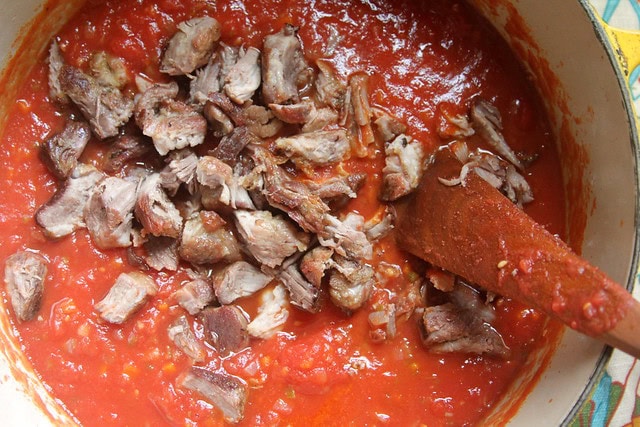
After cooking the tomatoes with the roasted pork for the requisite 2-3 hours that the recipe called for, the shreds of meat gave away with the nudge of a spatula against the sides of the pot. It needs a little coaxing like this, which you can do intermittently as you check in on your sauce and stir once in a while. There was plenty of meat to go around, too—I was glad I hadn’t added both sausages and pork to this meaty sauce, but then, Mrs. Muce’s recipe never listed exact quantities for either type of meat. Use as much as you like, one has to conclude.
Since meaty tomato sauce is a typical Italian American dish with so many iterations, this recipe was not exactly like finding some buried treasure map. Every household—that is, every home cook—has his or her own ways and even those vary depending on their mood and what’s available. Or whom you’re cooking or writing the recipe for. Unlike a cake, the whole process of cooking a long-simmered sauce is malleable. So rather than offering some unknown methodology, Mrs. Muce’s recipe, with its lack of detailed procedures or quantities, provided me with some decades-old proof of that. An historic document to “a little this, a little that.” And a lot of love.
Sunday Sauce with Roast Pork
(makes about 6-8 servings)
1.5 lbs pork chops or shoulder, cut to 2-inch pieces
1 medium-sized onion, finely chopped
2 stalks celery, finely chopped
1 small carrot, finely chopped
4 cloves garlic, minced
2 large cans whole peeled plum tomatoes
1 small can tomato paste
Olive oil, salt and pepper
Preheat oven to 325 degrees. In a large, oven-safe pan or Dutch oven, heat about 2 tablespoons of oil over high heat. Once sputtering, Add the chunks of pork and do not move; season liberally with salt and pepper and let cook about one minute or until brown and turn over. Let brown on the opposite sides. Remove from heat, and transfer to the oven to cook for 1 hour. Remove meat from the pot and let cool. Gently wipe oils from the pot with a paper towel, keeping any browned crust still on the bottom of the pot.
Meanwhile, add a couple tablespoons to a pan and add the chopped onion, celery and carrot, along with a generous pinch of salt. Cook over very low heat, stirring occasionally, for 20 minutes. Add the chopped garlic and continue cooking, stirring occasionally, on very low heat for another 15-20 minutes, or until the vegetables have shrank and turned into an almost pastelike consistency.
Once meat is cool enough to handle, gently shred by hand, removing any pieces of bone, tough cartilage or fat. Add the cooked vegetables to the pot that the meat was cooked in, and over low heat stir to scrape up any bits of browned crust. Add the tomatoes and tomato paste, continuing to stir and scrape away at the bottom of the pot until all the crusts have been loosened. Add the shredded meat to the pot and once it reaches a boil, reduce heat to a very low simmer. Cover the pot and cook for 2-3 hours, checking and stirring every hour.
Season with salt and pepper to taste, and serve with the pasta of your choice.
Cost Calculator
(for about 6-8 servings)
1.5 lbs pork shoulder (at $6.99/lb): $10.50
1 onion: $0.25
2 stalks celery: $0.25
1 carrot: $0.25
4 cloves garlic: $0.20
2 large cans whole peeled plum tomatoes: $5.00
1 can tomato paste: $1.00
olive oil, salt, pepper: $0.25
Total: $17.70
Health Factor![]()
![]()
![]()
![]()
![]()
![]()
![]() Seven brownie points: Slow-roasted pork and tomato sauce spread on pasta doesn’t have to be an artery-clogging main course, as you can make it more or less rich depending on how you prepare the meat. You can also use a small amount of sauce throughout your noodles and probably be satisfied. But it’s not a health food. Serve with a sauteed vegetable, salad, and pile on the parsley for a more well-rounded meal and it’s actually quite healthful.
Seven brownie points: Slow-roasted pork and tomato sauce spread on pasta doesn’t have to be an artery-clogging main course, as you can make it more or less rich depending on how you prepare the meat. You can also use a small amount of sauce throughout your noodles and probably be satisfied. But it’s not a health food. Serve with a sauteed vegetable, salad, and pile on the parsley for a more well-rounded meal and it’s actually quite healthful.
Green Factor![]()
![]()
![]() Three maple leaves: Using a small amount of pork for flavor a great deal of other foods is a good way to eat less meat, while not feel like you’re missing out on anything. Because red meat is so resource intensive, it leaves a huge carbon footprint compared to other types of meats—and especially vegetables. So go light on it, or skip it altogether.
Three maple leaves: Using a small amount of pork for flavor a great deal of other foods is a good way to eat less meat, while not feel like you’re missing out on anything. Because red meat is so resource intensive, it leaves a huge carbon footprint compared to other types of meats—and especially vegetables. So go light on it, or skip it altogether.